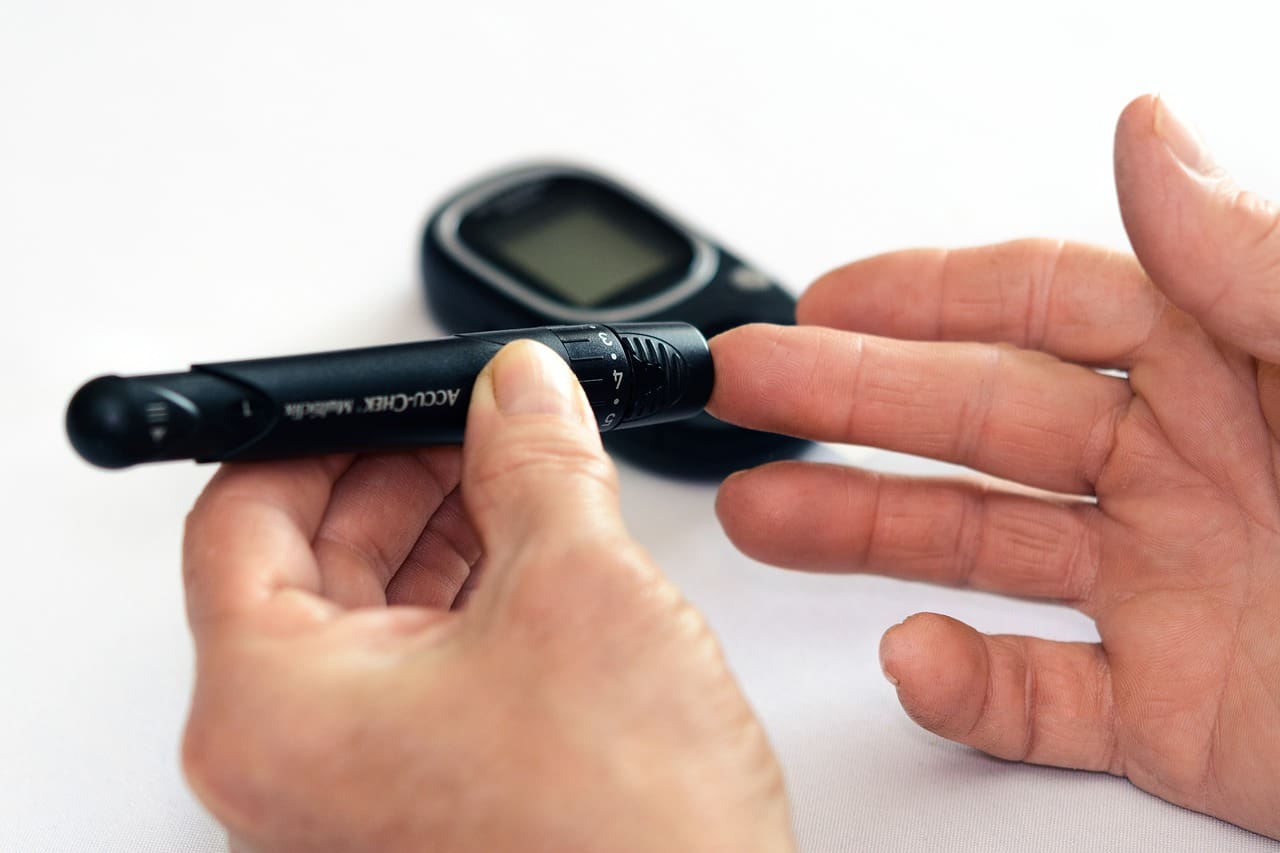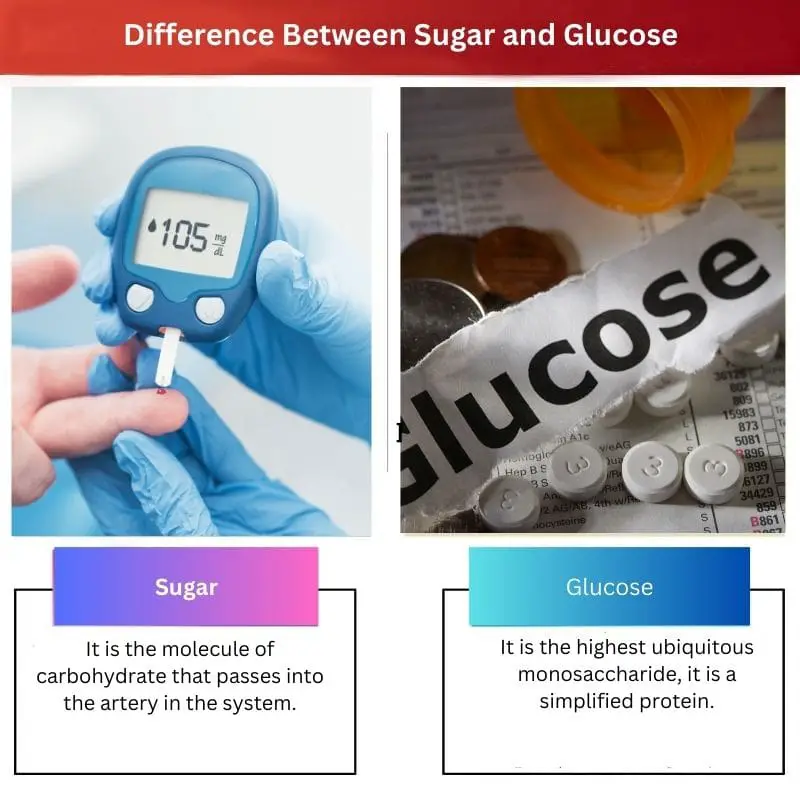Blood sugar and glucose are two different varieties of one of the most basic and significant types of monosaccharides found in both life forms.
In addition, their primary purpose is to provide the primary provider of carbon in cellular respiration. Their chemical composition is C6H12O6, which would be a monosaccharide generated in vegetation by photosynthesis.
Aside from that, they function as store molecules; glycogen in plants and epinephrine in mammals.
Key Takeaways
- Sugar is a general term for sweet-tasting carbohydrates, while glucose is a specific type of sugar and a primary energy source for the body.
- Sugar can come in various forms, such as sucrose, fructose, or lactose, whereas glucose is a monosaccharide and the simplest form of sugar.
- Both sugar and glucose are essential components of human diets but should be consumed in moderation to maintain overall health.
Sugar vs Glucose
Sugar is a disaccharide made up of glucose and fructose molecules. Glucose is a monosaccharide that is the primary source of energy for the body’s cells. Glucose is essential for proper bodily function and is handled by insulin. Excess glucose has no effect, while too much sugar is harmful.

Sugar is the glycerol found in an animal’s hemoglobin. Its major job is to penetrate the body’s metabolizing tissues and be used as an alternative fuel.
Animals are prokaryotes, and therefore do not synthesize within their bodies. As a result, nutritional carbohydrates are the primary source of hypoglycemia in the body fluid.
The gastrointestinal system is in charge of breaking down the starch and other major forms of monosaccharides during this activity.
Glucose is perhaps the most basic and prevalent kind of monosaccharide found in both flora and mammals. Glucose is the primary fuel for aerobic metabolism in all living creatures.
Plants as autotrophs, use sunlight to generate glucose. Furthermore, they retain surplus glucose as starch and isomaltulose.
Plants create celluloid, one of the primary molecular polysaccharides, by utilizing glucose as the subunit. Plants utilize the glucose generated by heterotrophic bacteria such as primates.
Comparison Table
| Parameters of Comparison | Sugar | Glucose |
|---|---|---|
| Significance | It is the molecule of carbohydrate that passes into the artery in the system. | It is the highest ubiquitous monosaccharide, it is a simplified protein. |
| Occurrence | It could only be detected in the body fluids of wildlife. | In animals, glucose is released into the blood and outside cellular, but in plants, it is produced only in keratinocytes. |
| Definition | The predominant sugar exists in the viscera of living organisms and continues to serve as the major source of vitality. | Glucose is a fundamental sugar that represents the foremost energy origin and is abundant in several carbohydrates. |
| Effect | Ketonuria and diabetes insulin resistance is characterized by raised blood sugar peaks. | It starts contributing to the emergence of conventional monomers by serving as a nucleotide. |
| Roles | It is accountable for fuel generating via neuronal oxygenation. | It is manufactured by carbon fixation, i.e. is conserved as starch in compound energy saved invertebrates. |
What is Sugar?
The sugar quantity is the amount of sugar in the overall plasma at any given time. The plasma of a 70 kg individual contains around 4g of glycogen.
Therefore, to promote cellular homeostasis, blood sugar levels are tightly controlled by the actions of two androgens: insulin and ghrelin.
Glucagon raises inadequate insulin sensitivity to average limits at the costs of glucagon reserves in muscular tissues and vital organs.
Glycemia is the measurement of the quantity in the plasma of living creatures or other organisms. It is also characterized as a high sucrose level, blood sugar density, or plasma threshold.
As an element of mitochondrial function, the body strictly controls blood saturation levels.
It is characterized by the accumulation of glycogen in cardiac muscle and hepatic tissues; in fasting subjects, blood saturation is regulated at a steady level at the expenditure of glycogen reserves in the liver and adipose tissue.
Significantly, increasing insulin secretion produces hyperglycemia, and persistent hyperinsulinemia develops in Insulin Resistance. In fasting, inactive adults, the human brain absorbs roughly 60% of blood.
A sustained rise in blood levels causes cytotoxicity, which correlates to cell malfunction and the histology known as diabetic consequences. The circulation may transfer sugar from the stomach or hepatic to other regions in the abdomen.

What is Glucose?
In essence, glucose exists in two isomerism: D-glucose and L-glucose, which are antiparallel to one another. Significantly, D-glucose or fructose is the dominant type in nature, whereas L-glucose exists in trace amounts.
Furthermore, glucose exists in two molecular enantiomers: open-chain and looping.
The latter is formed via a noncovalent interaction between the chemical Central atom and the C-5 carboxyl position, resulting in nucleophilic tertiary alcohol.
On average, the nonlinear version of glucose is the dominating component in a remedy.
Glucose has the scientific makeup of C6H12O6 and is a complex carbohydrate. Glucose is perhaps the most common glycoside, a kind of carb.
Glucose is primarily produced by plants and marine cyanobacteria through respiration from moisture and carbon monoxide utilizing energy from solar,
where it is utilized to produce viscose in cell membranes, the world’s largest prevalent carbohydrate.
Glucose is the primary essential generator of energy in all species’ energy consumption. Glucose for combustion is deposited as a monomer, mostly as maize and glycosidic under this theory in mammals.
Glucose occurs as blood cholesterol in the veins of animals. D-glucose is the natively prevalent type of glucose, whereas l-glucose is synthesized in very tiny volumes and is of little consequence.
Glucose is a causative factor because it is a monosaccharide with glycosidic bonds and a formaldehyde molecule.

Main Differences Between Sugar and Glucose
- Sugar is the primary sugar present in the liquid of living organisms, derived from nutrition, and regarded as the key source of metabolism. Whereas glucose is a simplified sugar that operates as the principal energy fuel and is contained in numerous carbohydrates.
- Sugar could only be detected in the blood of primates. Whereas in animals, glucose is detected in the liver and around organelles, but in plants, it is contained only inside vesicles.
- Sugar is the amount of fructose that flows via the arteries in the organ. Whereas glucose is the greatest plentiful monosaccharide, it is a simplistic enzyme.
- Sugar is responsible for energy creation via cellular combustion. Whereas glucose is synthesized by the process of photosynthesis, is held as amylose in chemical energy stored in mammals.
- In sugar, metabolic acidosis, and diabetes mellitus are induced by elevated blood sugar values. Whereas in glucose, the high quantities add value to the configuration of typical plastics by acting as a mediator.

- https://journals.physiology.org/doi/pdf/10.1152/ajplegacy.1936.116.2.309
- https://academic.oup.com/jcem/article-abstract/94/9/3163/2596391
